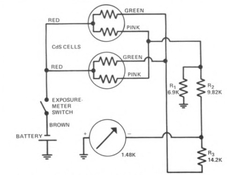back2vinyl
Member
OP, I presume you want to sell your solution. Folks are interested in solving their problem with a different solution if the newer solution is either
So which of those benefits applies, which would make OP's solution worth bringing to market? Where is OP's product's position in the marketplace going to be? Or is this simply an engineering exercise, and not intended to be offered to buyers?
- technically better
- cheaper to use
- some other advantage over the pre-existing solutions
I have zero interest in selling anything. I was just curious what values to use in the resistor circuit to make it work with a silver oxide battery. I also wanted to improve my understanding of how light meters work, and this seemed like a good way to do that. When you own old stuff, it can pay to know how it works in case it breaks.





 This would give the currents that the ammeter sees, and you could then compare these with the currents you get with different LDR values in the situation with a nominal 1.35V supply to the network.
This would give the currents that the ammeter sees, and you could then compare these with the currents you get with different LDR values in the situation with a nominal 1.35V supply to the network. 




